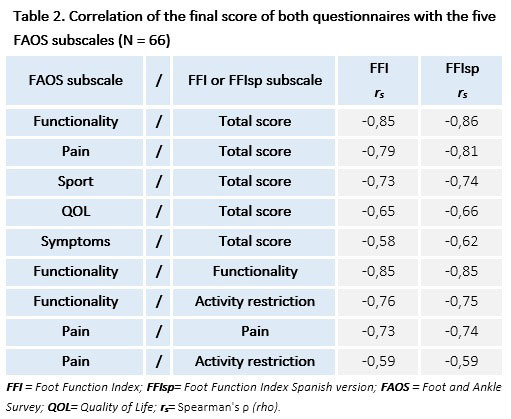Session Information
Session Type: Poster Session B
Session Time: 9:00AM-10:30AM
Background/Purpose: Multiple questionnaires and objective assessment tools have been developed to determine functional compromise in Rheumatoid Arthritis (RA). One of the most used tools to measure the impact on foot joints is the Foot Function Index (FFI), self-administered questionnaire of 23 items organized within 3 domains (pain, disability, and activity restriction). The Index has two versions, the original one (FFI) with a scale from 0 to 9 for each question, and the Spanish version (FFIsp) from 0 to 10. Both make use of a formula, resulting in a final score between 0 to 100%. The aim of this study was to evaluate the performance of both versions of the FFI questionnaire in a cohort of RA patients residing in Argentina.
Methods: Analytical, observational, cross-sectional study. Patients ≥ 18 years with a diagnosis of RA (2010 ACR/EULAR criteria) were included. Sociodemographic and disease characteristics, clinimetric measures and current treatment were recorded. Foot anatomical alterations, and use of devices and adaptations were registered. All patients completed FFI, FFIsp and the Health Assessment Questionnaire Argentine version (HAQ-A), Quality of Life-Rheumatoid Arthritis II (QOL- RA II) and the 5 subscales of the Foot and Ankle Survey (FAOS). Statistical analysis: Descriptive statistics. Internal consistency was evaluated with Cronbach’s α. Association between FFI score, and sociodemographic and disease characteristics was analyzed. Multidimensional FAOS questionnaire, clinimetric measures and composite indices were used to determine criterion validity. The Spearman’s rank correlation coefficient was applied on each functional capacity scale. All p values were corrected using the Bonferroni method.
Results: Sixty-six patients were included: 91% were women, mean age 54 years (SD 12) and median disease duration 90 months (IQR 48-156). Ninety-seven percent were positive for RF and 81% for ACPA, 63.6% had erosive disease and 51.5% extra-articular manifestations. Approximately 42% had foot deformities and altered plantar support, only 6.1% required assistance to walk and 4.6% used assistive devices. Results of clinical measurements can be observed in Table 1. Internal consistency was good for both versions (α-Cronbach= 0.72 & 0.75). Intra-item correlation did not evidence redundant questions. Correlation between domain scores (α-Cronbach=0.97 to 0.99) and the final score (α-Cronbach=0.98) of both versions was excellent. Correlation of both Index with FAOS subscales is shown in Table 2. Disability and activity limitation subscales of FFI and FFIsp showed a high correlation with functionality subscale of FAOS. The correlation of Pain subscales and FAOS pain subscale was also high. Correlation between the limitation subscale and FAOS quality of life subscale was moderate. Both versions of FFI showed a moderate correlation with foot visual analog scale (r=0.60 & 0.60) and a little higher correlation with HAQ-A (r=0.66 & 0.68). The correlation with DAS28 was regular (r=0.40 & 0.38). There was no correlation with sociodemographic characteristics or quality of life.
Conclusion: FFI and FFIsp proved to be reliable and valid in patients with RA, providing a useful tool to evaluate the functional capacity of the foot.
To cite this abstract in AMA style:
Dapeña J, Alascio L, Serrano E, Bande J, Medina M, Klajn D, Caracciolo J, Papasidero S. Performance of the Foot Function Index Questionnaire in Patients with Rheumatoid Arthritis [abstract]. Arthritis Rheumatol. 2022; 74 (suppl 9). https://acrabstracts.org/abstract/performance-of-the-foot-function-index-questionnaire-in-patients-with-rheumatoid-arthritis/. Accessed .« Back to ACR Convergence 2022
ACR Meeting Abstracts - https://acrabstracts.org/abstract/performance-of-the-foot-function-index-questionnaire-in-patients-with-rheumatoid-arthritis/


